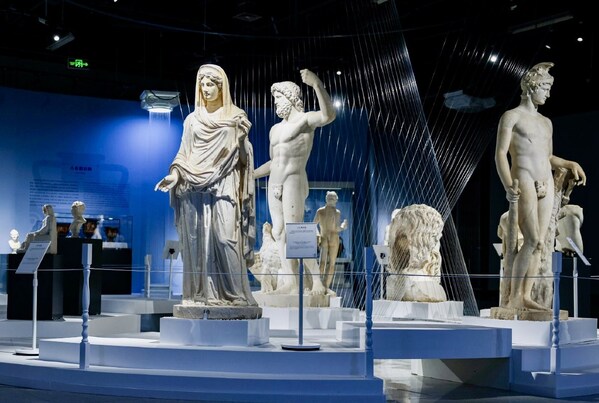BEIJING,Dec. 27,2024 -- A report from China Daily:

The statues of various Greek deities are among the cultural treasures to go on show at the exhibition.
The sculptural arts are one of the gems of the ancient Greek and Roman civilizations. Residents in North China's Shanxi province will have an opportunity to glimpse the essence of these cultural assets as an ancient sculpture arts exhibition will kick off at the beginning of the new year at Shanxi Museum in Taiyuan,the provincial capital.
The event,called "Classical and Glory" Ancient Greek and Roman Sculpture Arts Exhibition,will open on Wednesday.
The event's organizers said that this exhibition will be not only a display of artworks but "a dialogue of civilizations".
Shanxi is one of the cradles of Chinese culture,with its earliest ancient civilization reaching its peak some 3,000 years ago. This was evidenced in an archaeological discovery at the Taosi site in Xiangfen county,which pointed to the formation of one of the earliest states in China.
That was roughly when the city states emerged in ancient Greece,which had ushered in a period of social and cultural prosperity for more than 600 years — from c.8th century to c.2nd century. Even after the fall of ancient Greece in 146 BC,its culture and arts continued to influence those of the ancient Roman Empire,which began in the early 1st century.
The ancient Greek and Roman cultures are the origins of Western civilization. The two cultures feature a continuity and ancient Roman Culture has a strong influence and inheritance from ancient Greek Culture.
And this is especially true in the sculptural arts. During the Hellenistic and Classical period,ancient Greek sculptors aimed to depict the human form realistically but in an idealized and harmonious manner. Ancient Greek sculptors carefully studied human anatomy and sought to capture the essence of physical perfection and inner vitality. Deities were the common subjects featured in the sculptors' works.
There were also remarkable similarities in the works created by ancient Roman sculptors. Roman sculpture is known for its grandeur and realism.
Like the Greeks,Roman sculptural artist strove for perfection and illustrated its subjects in this manner. The Greek and Roman sculptural arts also pursued a similar level of aesthetics in geometry.
At the exhibition at Shanxi Museum,a total of 134 ancient Greek and Roman sculptures will be on display. The exhibition will be arranged in five sections to present the arts of different locales,periods and styles. The five sections are called "Gods of the Olympus","Blessing from Gods","the Grandeur of Augustan Arts","Garden of Rome" and "External Vitality".
The Gods of Olympus section features the sculptures created in the Classical Period of ancient Greece,from 480 to 325 BC. The works highlight a style of harmony,grandeur and idealism. In addition,other cultural relics of that period,like attic-style vases and pottery vessels,will be on show.
There are also sculptures created by Roman sculptors imitating the classical Greek style. One exhibit is the Apollo Sauroktonos,a sculpture created by ancient Roman sculptor Praxiteles featuring a bow-holding Apollo fixing his sights on a lizard. Despite its inheritance of the classical style,a prominent characteristic of the sculpture is that Apollo was not portrayed as a god of grandeur,but a young man of beauty and tenderness.
The Blessing from Gods section features works created in the transitional period from the ancient Greek to ancient Roman. Deities of the early Roman mythology are major subjects of the works. While the inheritance of classical Greek style is still visible,the works show a balance of solemnity and amiability of the deities,which are depicted in smoother lines and more casual postures.
The Grandeur of Augustan Arts section mainly features the busts of the Augustan period. The style of sculptures shows a completion of the Greek-Roman transition,with an emphasis on realism and details. The busts,depicting real or realistic looking people,are one of the major contributions that ancient Roman sculptors made to the world. A bust usually features great detail in the facial expression to highlight the personality of the individual.
The Garden of Rome section aims to present the lives of ancient Romans by exhibiting sculptures,glassware and mosaic arts of that period.
The External Vitality section mainly displays sculptures and other articles relating to funeral and burial ceremonies during the ancient Roman period.
Thinking about life and death was a major part of the philosophic framework of the ancient Romans and was also a theme of the period's sculptural art.
Ancient Greek and Roman sculpture has influenced art in many regions of the world. And this influence also reached China's Shanxi province,said an expert at Shanxi Museum.
One of the three Buddhist cave art treasure houses in China,Yungang Grottoes in Shanxi's Datong city,is a monumental work of the cultural integration between China and the West. In the processing of creating cave statues more than 1,500 years ago,the influence of the Gandhara art was remarkable.
Gandhara,an ancient region spanning what is now northwest Pakistan and parts of east Afghanistan,was historically a crossroads linking India,Persia and other cultural centers as faraway as ancient Greece.
Gandhara Buddhist art is a unique art style that blends Greco-Persian and Buddhist influences.
Many Buddhist statues can be found along the route of Buddhism's spread in China,like the Mogao Grottoes in Gansu,Yungang Grottoes in Shanxi and Longmen Grottoes in Henan.
"In Yungang Grottoes,the Gandhara or even Greek elements are visible on many Buddha statues,like the curly hair and details of clothes," he added.
"After the communication and integration among different cultures that lasted for thousands of years,Shanxi Museum deems it an important mission to continue the cultural exchanges in the context of a modern era," said the expert. The "Classical and Glory" Ancient Greek and Roman Sculpture Arts Exhibition is the latest move in this effort.